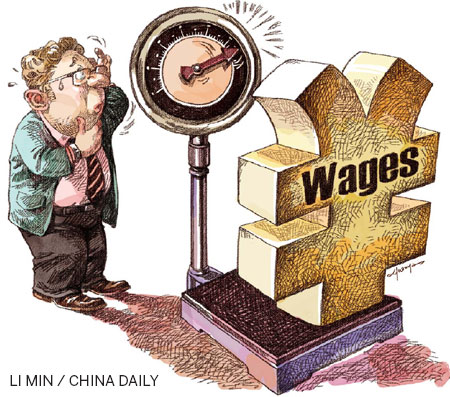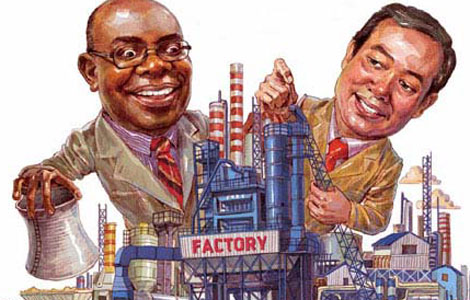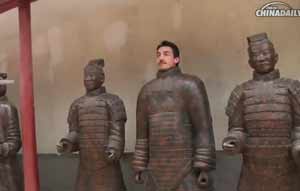Wages reach point of no return
Updated: 2013-05-10 08:49
By Kelvin Lau and Stephen Green (China Daily)
|
|||||||||||

As a nobel-prize winner's theory becomes reality, chinese firms face difficult choices
China has reached its Lewis turning point. This is a critical milestone for a developing economy, when urban factories, restaurants and other businesses have to start raising wages faster than the inflation rate to attract rural workers. Until that point, factory wages can remain flat and still attract farm workers living on subsistence incomes at home. It will take years for China to reach the end of the turning point, when urban and rural wages are equal. Until then, the increase in real wages for unskilled workers is here to stay.
We saw further evidence of this in our recent survey of manufacturing clients in the Pearl River Delta region, the industrial powerhouse in southern China. The annual survey, conducted after the Lunar New Year holidays, showed that manufacturing wage growth across the region is likely to accelerate to an average 9.2 percent this year, from 7.6 percent last year.
Salary increases are outpacing consumer price inflation, which we estimate will accelerate to 4 percent this year, from 2.6 percent last year. This extends a long-running trend of rising real wages, and provides further confirmation that China has reached the Lewis turning point, named after Nobel prize-winning economist Arthur Lewis.
The implications of rising wages are huge. Higher incomes help China move closer to its goal of becoming a domestic consumption-driven economy and away from its current investment-dependent structure. But they also leave companies across the Pearl River Delta region with three options: move their factories inland, where labor is cheaper; shift plants overseas; or step up automation to save on labor costs. The majority of the companies in our survey say they plan to go for the third option, at least for now, although an increasing number are looking at the other two.
Although the rise in remuneration may be partly driven by minimum wage increases and stricter enforcement of social insurance contributions, the majority of our clients believe that growing labor shortages are the main cause. Fortunately, most companies also say that output per worker has risen faster than wages, a sign that wage growth is backed up by productivity.
Wage pressure has clearly increased over the past 12 months. Relative to last year's survey, more companies expect a more than 10 percent increase in salaries this year, while fewer companies expect no increase at all. Almost one-third of the companies surveyed said labor shortage has worsened since 2011.
Our survey results indicate that there were no material job losses during last year's downturn. They also show that demand from within both China and abroad is picking up again. More than half the companies in the survey said they expected their orders to increase over the next three months; a quarter were operating their plants at full capacity, while the majority were running at more than 80 percent capacity.
Last year's slowdown, triggered in part by government policy measures to cool the domestic housing market and exacerbated by Europe's economic crisis, caused China's economic growth to slump to 7.7 percent - the lowest in more than a decade. We expect growth to accelerate to about 8.3 percent this year.
Wage increases are partly government-driven. China's 12th Five Year Plan (2011-15) aims to raise the national minimum wage by an average of at least 13 percent each year, faster than in previous years. Local authorities are free to set their wages above the national level. In fact, provinces have increased minimum wages by an average of 16 percent this year, following a 20 percent increase last year.
Shenzhen in the delta region tops the list in terms of minimum wages, with minimum monthly pay of 1,600 yuan ($260; 200 euros). This has forced more than half the companies in our survey to raise wages more than they had planned to, particularly for their least skilled workforce.
As salaries rise, only the fittest will survive. Naturally, larger companies are better able to compete by investing more in technology and securing larger, longer-term orders from overseas customers. Three out of five companies surveyed said they are responding with bigger investments in machinery. They are also investing in process automation tools, outsourcing or partially sub-contracting production, boosting in-house design functions, and hiring employment agencies to find new workers.
Moving production to cheaper locations is also an option, but a costly one. And such decisions are not driven purely by labor cost considerations. Relocation means losing proximity to suppliers and customers, dealing with new tax and regulatory regimes, and bearing higher transport costs. That said, our survey suggests that companies are increasingly willing to consider moving out of the delta region or expanding to new locations.
About 30 percent of the companies surveyed said they planned to move factories inland, while 10 percent said they would move out of China. Both figures are more than double that of last year's. Within China, many companies want to move westward to the Guangxi Zhuang autonomous region, where wages are 30 percent lower. Other popular destinations include Jiangsu, Hunan, Hubei and Jiangxi provinces. The favoured overseas destinations are Cambodia, Bangladesh and Vietnam.
Labor shortage has long been a challenge in the region. But manufacturing wage trends of the past few years in the region reflect the nationwide situation because the labor market is highly mobile. A squeeze on the surplus labor pool in the delta leads to rising inland wages and pushes up real wages for migrants leaving agricultural jobs.
There is also a new element fuelling the wage spiral - China's aging workforce. The number of people aged between 15 and 59 years fell by 3.45 million in 2012, the first absolute decrease in the labor force since the late 1970s. Add this ingredient to the mix, and it is easy to see why the Lewis turning point has arrived in China a few years earlier than many had expected.
Kelvin Lau is senior economist and Stephen Green is head of Greater China Research at Standard Chartered Bank. The views do not necessarily reflect those of China Daily.
(China Daily 05/10/2013 page9)
Today's Top News
List of approved GM food clarified
ID checks for express deliveries in Guangdong
Govt to expand elderly care
University asks freshmen to sign suicide disclaimer
Tibet gears up for new climbing season
Media asked to promote Sino-Indian ties
Shots fired at Washington Navy Yard
Minimum growth rate set at 7%
Hot Topics
Lunar probe , China growth forecasts, Emission rules get tougher, China seen through 'colored lens', International board,
Editor's Picks

|

|

|

|

|

|





